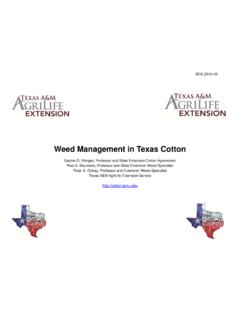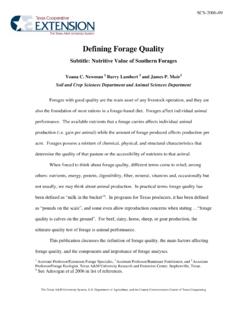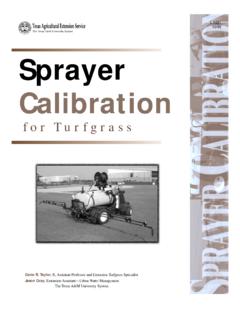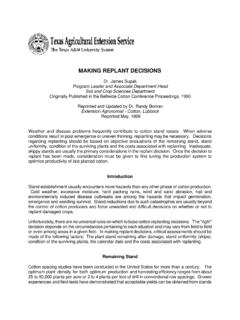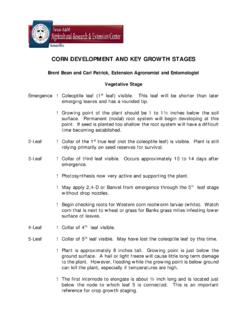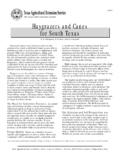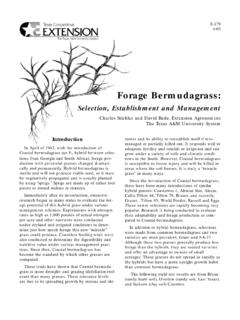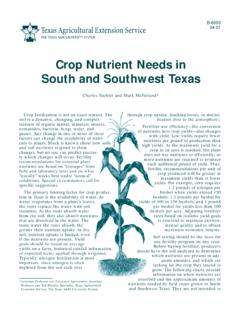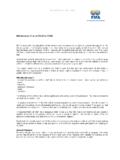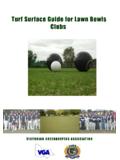Transcription of Maintaining Bermudagrass Lawns - Texas A&M …
1 L-5339. 11/99. Maintaining Bermudagrass Lawns Gene R. Taylor II, Assistant Professor and Extension Turfgrass Specialist Jason Gray, Extension Assistant Turfgrass Management The Texas A&M University System It is best not to bag grass clippings. They decompose Y our Bermudagrass lawn can be healthy and attractive if you give it proper care. quickly and return many nutrients to the soil. If you do bag the clippings, consider composting them to use in the landscape. Fertilizing Begin fertilizing after the grass turns green and there is Bermudagrass (Cynodon dactylon [L.]) is a popular little chance of a late frost. Have the soil tested to determine turfgrass for Lawns , golf courses, athletic fields and general what nutrients your lawn needs. For information on soil utility areas. Found in Australia, Africa, India, South America testing procedures, contact your county Extension agent.
2 If and the southern United States, it grows well in nearly all soil you do not have the soil tested, use a complete fertilizer with types and resists drought. Bermudagrass ranges from very fine a 3-1-2 ratio of nitrogen, phosphorus and potassium to coarse leaf texture, and it has a low, dense growth habit. It (Examples: 15-5-10, 21-7-14, etc. Every bag of fertilizer has spreads both above ground (stolons) and below ground the nutritional analysis printed on the bag). (rhizomes), which makes it very aggressive and able to wear Apply 1 pound of soluble nitrogen per 1,000 square feet well and compete successfully with most weed species. of lawn every 4 to 6 weeks, or 11/2 pounds of slow-release The biggest negatives to Bermudagrass are that it tends to nitrogen fertilizer every 8 to 10 weeks. To determine the creep into flower beds, and it does not tolerate shade well.
3 Amount of fertilizer to apply to equal 1 pound of nitrogen Do not select Bermudagrass for Lawns that are shady. per 1,000 square feet, divide 100 by the first number in the Coarse-textured varieties such as Common Bermudagrass fertilizer analysis. (To determine the amount needed to apply can be established from seed, sprigs, plugs or sod. They pounds per 1,000 square feet, substitute 150 for 100.). require less management than some other Bermudagrass For example, if you are using a 15-5-10 fertilizer, then varieties, but normally produce a lower quality lawn . pounds of fertilizer per 1,000 square feet will be needed. Hybrid varieties such as Tifway 419 have a finer texture 100 15 = and produce very high quality Lawns . However, they require Then determine the size of the area to be fertilized. If more maintenance than coarse-textured varieties.
4 The hybrid your lawn is 5,000 square feet, it will need 33 pounds of 15- varieties do not produce viable seed and must be grown 5-10 fertilizer. from sprigs, plugs or sod. (5,000 1,000) x = 33 pounds of fertilizer Dwarf varieties such as Champion or Tifdwarf are finely textured grasses for use on golf course greens that require Watering intensive management. They are not recommended for To keep your lawn healthy, water it only when the grass home Lawns . needs it. When you do water, wet the soil to a depth of 6. Follow these guidelines for mowing, watering and inches. Don't water again until the grass shows symptoms of fertilizing your Bermudagrass lawn , as well as for drought stress a dull bluish color, rolled or folded leaves, controlling weeds, insects and thatch, and eliminating and persistent footprints. This usually occurs in 5 to 10 days, compacted soil.
5 Because many factors can affect turf depending on the weather. growth, these are general recommendations. Follow these steps to determine how long to water in order to apply the right amount. 1. Set out five or six open-top cans randomly around the MARCH through May Mowing lawn (tuna or cat food cans work best). Begin routine mowing as soon as the grass begins to turn 2. Turn on the sprinklers or irrigation system for 30 minutes. green in the spring. Set the mowing height at 1 to 2 inches 3. Using a ruler, measure the depth of water in each for Common Bermudagrass and 1/2 to 11/2 inches for hybrid individual can, and record the depths. varieties. Remove no more than one-third of the leaf area 4. Calculate the average depth of water from all of the cans. with any one mowing. The lower the mowing height, the Example: You have placed five cans in your yard.
6 The more frequently you will need to mow. The grass will be depths of water in the cans were inch, inch, much better quality if you mow frequently at a lower height. inch, inch and inch. Add the depths together and divide by the number of cans you used. + + + + = inches inches 5 cans = inch of water in 30 minutes 5. Use a garden spade or a soil probe to find out how deeply the soil was wet during the 30-minute period. The probe will push through wet soil easily, but it will be more difficult to push through dry soil. Bermudagrass grows well in nearly all soil types. 6. When you know how much water was carefully before applying any herbicide to applied in 30 minutes and how deeply that ensure that it is the right product for the weeds volume of water wet the soil, determine how you have and that it does not damage the turf. long you must water to wet the soil to a Follow all the instructions on the label.
7 It depth of 6 inches. explains how and when to use the product and Example: If the sprinklers sprayed inch how much to apply. of water in 30 minutes and wet the soil to a depth of 3 inches, you would need to apply 1 Controlling insects inch of water to wet the soil to a depth of 6 Armyworms, Bermudagrass mites and white inches. To do so you must water for 1 hour. grubs can seriously injure Bermudagrass Lawns Run-off from watering a lawn can waste a (see L-1131, White Grubs in Texas Turfgrass, . significant amount of water, which is costly and available from the Texas Agricultural Extension a poor use of a limited natural resource. The Service). Check for these pests routinely and factors determining how quickly run-off occurs treat as necessary. are the type of soil and the application rate of If you suspect that nematodes are in your the sprinkler system.
8 Do not apply water faster lawn , send a soil sample to the Plant Disease than the soil can absorb it. To prevent run-off: Diagnostic Laboratory for testing. Contact your 1. Check the lawn while watering. If water county Extension agent for more information. begins running into the streets or gutters, note how long it took before run-off occurred. This is the maximum amount of time you should water at one time. 2. Stop watering and allow the soil surface to dry (30 minutes to 1 hour). 3. Begin watering again and continue for the amount of time you've determined. With an automatic irrigation system, change the timer to the new, shorter time. 4. Continue this cycle until the appropriate amount of water has been applied to wet the soil to a depth of 6 inches. New-style irrigation controllers allow you to water several times a day, so that you can Begin mowing as soon as the Bermudagrass begins to turn program them to prevent run-off.
9 Green in the spring. Controlling weeds Controlling thatch The best form of weed control is a healthy, If the thatch layer (layer of undecomposed dense, actively growing lawn . To control plant matter) is more than 1/2 inch thick, mow crabgrass and other grassy weeds, apply the lawn with a vertical mower in May when preemergent herbicides (which control weeds the grass is healthy and actively growing. Be before they sprout from the ground) in the sure to remove the organic matter that the spring when the soil temperature reaches 65 F vertical mower brings up from the lawn surface. (your county Extension agent can give you an To prevent thatch, avoid excessive fertilizing estimate of this date in your area), or when the and watering. For more information on thatch, redbud and dogwood trees begin to bloom. see the Extension publication L-5226, Thatch Apply postemergent herbicides (which control Management for Home Lawns .)
10 Weeds that have already sprouted) when weeds are present and the grass is healthy and actively Eliminating compacted soil growing. In areas of heavy traffic, aerate the soil Control broadleaf weeds with herbicides that several times a year to help loosen compacted contain 2,4-D, MCPP or dicamba. Grassy earth. Use a core-aerating machine when the weeds can be controlled by applying MSMA at grass is actively growing. If you have an 7- to 10-day intervals. Weed control is most underground irrigation system, flag the effective if you apply the herbicide when the sprinkler heads first to avoid damaging them. weeds are still very small. Read the label JUNE through August Fertilizing Mowing Do not fertilize Bermudagrass unless the lawn has been Follow the same recommendations as for March through overseeded. Overseeded Lawns should be fertilized once in May.
